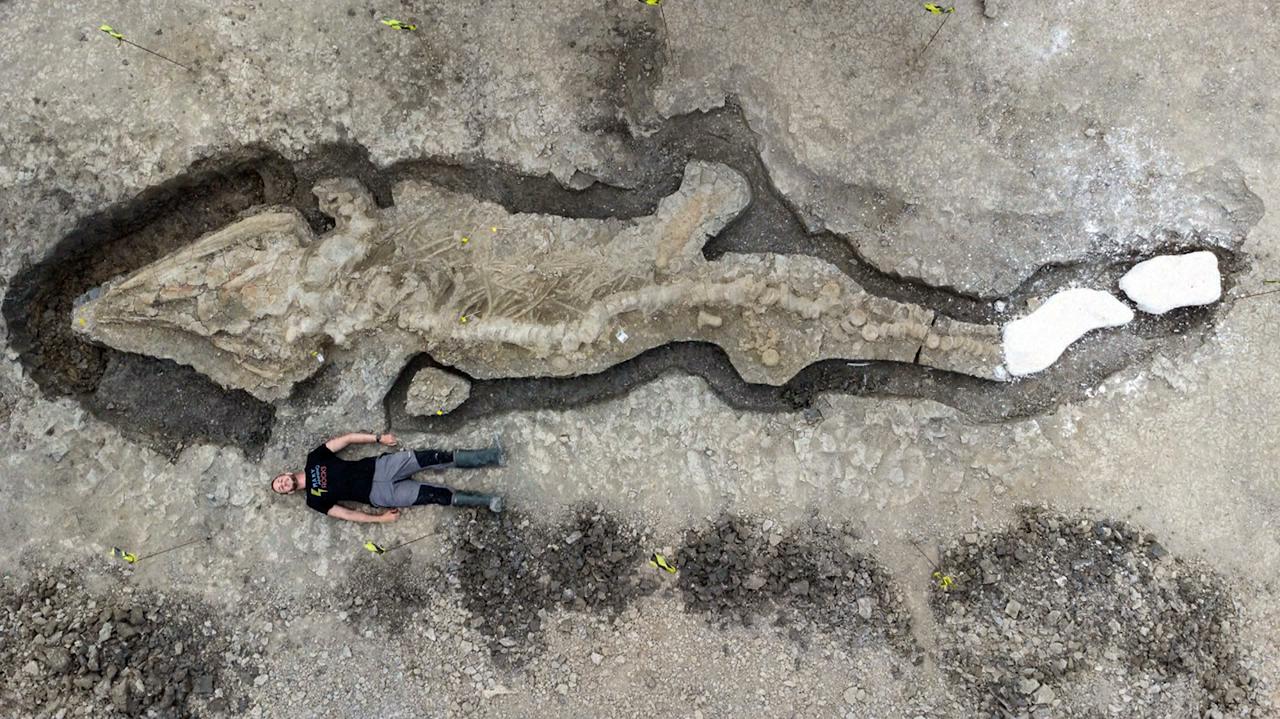Ichthyosaurs, colloquially “sea dragons”, are prehistoric marine reptiles that lived in the world 90-250 million years ago. Paleontologists in Great Britain discovered the huge fossilized remains of such an animal. Researchers assure that such well-preserved remains of an ancient predator have never been found so far from the sea. The discovery was made in the English Rutland Water Nature Reserve.
“Every day is different when you’re working in a nature reserve, but nothing could have prepared our team for the day we brought fossil discovery to life!” — Staff at Rutland Water Nature Reserve wrote on Twitter on Monday bragging about their discovery — the fossilized remains of the mighty ichthyosaur, the “sea dragon.”
“Sea Dragon” – How was it found
It all started about a year ago. Joe Davis, an employee of Rutland Water Nature Reserve – a large-scale protected wetland in England where bird-watching enthusiasts go – worked on a body of water in February 2021. Once he saw that “something strange” was coming out of the mud.
I looked at what looked like stones and thought they looked a little organic, a little different. Then I saw what looked like a lower jaw, Davis said. “I called the county council and said I think I found the dinosaur,” he said.
It turns out, yes, this is the remains of an ancient reptile, but not the land, but the sea – a predator called ichthyosaur, or sea dragon. “A lot of people thought I was cheating when I said I found the remains of a great marine reptile at work,” Davis boasted.
Ichthyosaur foundENEX
One of the greatest discoveries in the history of British paleontology
Paleontologists from various universities and research centers in Great Britain came to the site. They confirmed that the 10-meter-long find was the remains of an ichthyosaur – a warm-blooded, air-breathing sea predator, similar in appearance to today’s dolphins. The length of the “sea dragons” can reach 25 meters. They lived on Earth 90-250 million years ago.
The first complete remains of an ichthyosaur were discovered at the beginning of the 19th century by British paleontologist Mary Anning. Earlier – even in the seventeenth century – only parts of it were found. However, what the Rutland wetlands have now revealed is a unique discovery in many ways.
Dr Dean Lomax, the University of Manchester paleontologist responsible, described the find as “truly unprecedented” – and because of the size and completeness of the remains – “one of the greatest discoveries in the history of British paleontology.” We usually think of ichthyosaurs and other marine reptiles found along the coast in Dorset or Yorkshire. Many of them are exposed due to shelf erosion. He emphasized that the situation here, in remote areas, is very unusual.
Rutland is located about 50 kilometers from the coast, but 200 million years ago it would have been in the shallow waters of the ocean.

Found “Sea Dragon”Reuters
The skull of an ichthyosaur alone weighed a ton
When the water level in the reserve’s reservoir fell in the late summer of 2021, a team of paleontologists began exhuming the remains. Working on an animal’s skull requires special care. The large block of clay that contained the head of the giant ichthyosaur was carefully excavated, then covered with plaster and placed on wooden bars. It weighed about a ton. After he was moved, more research began around him.
“You’re not often responsible for picking up a very important but very fragile fossil that weighs a lot,” noted Nigel Larkin, a paleontologist at the University of Reading. “It’s a responsibility, but I like challenges like this,” he added.
Anglian Water, which operates the Rutland Reservoir, is seeking funding so that “their” ichthyosaur remains in the area where the discovery was made, and visitors to the reserve can see it.

The length of the ichthyosaur was about 10 metersReuters
Main image source: ENEX

“Coffee enthusiast. Troublemaker. Incurable introvert. Subtly charming twitter scholar. Award-winning social mediaholic. Internet buff.”









